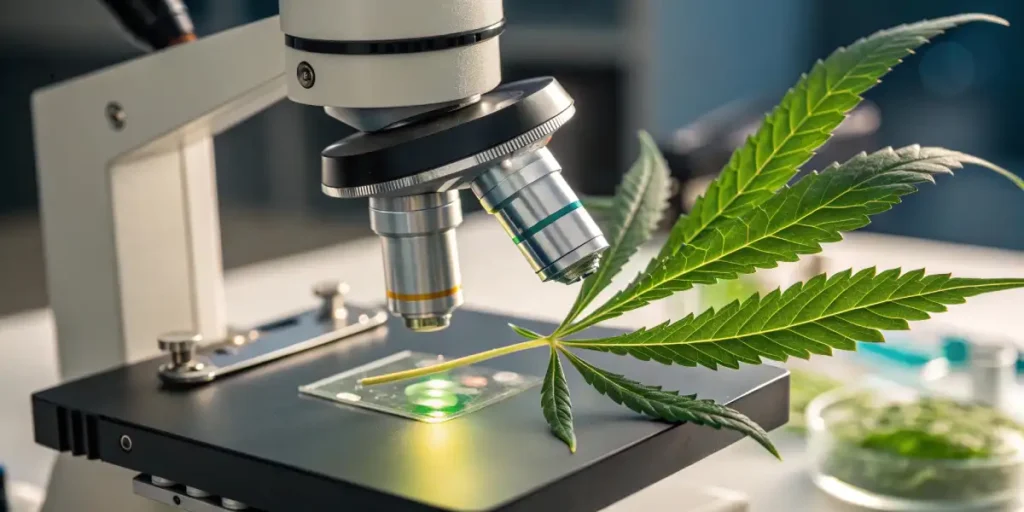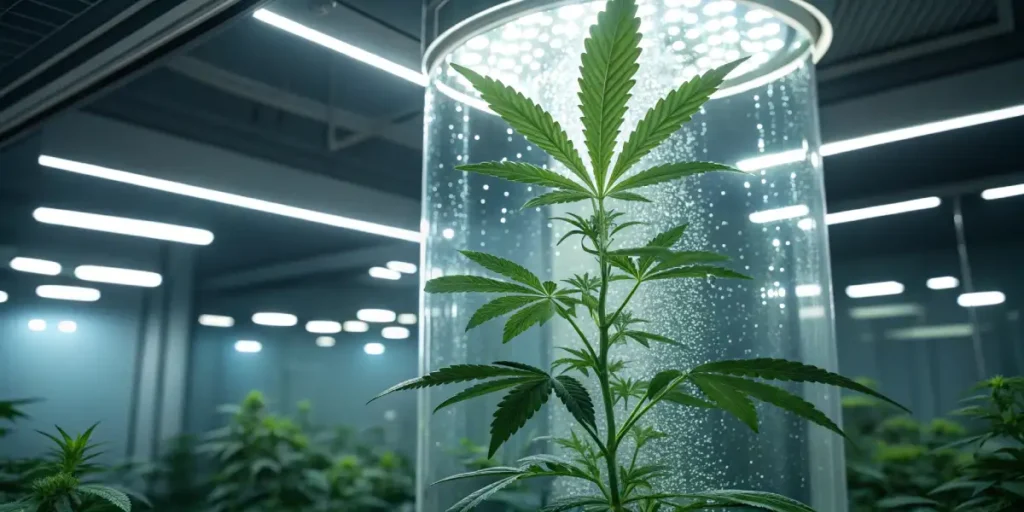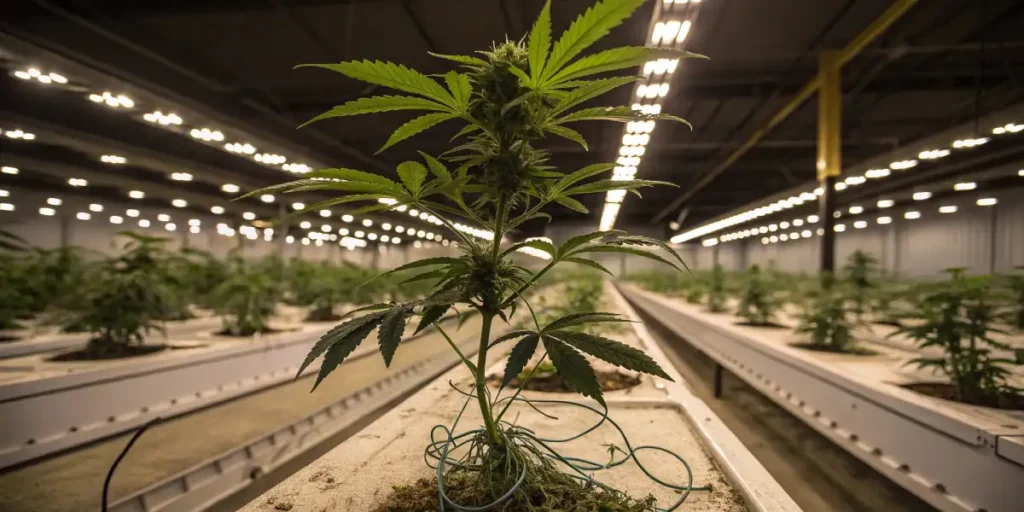
What is Apoplast Pathway in Cannabis?
What is apoplast pathway in cannabis? Is a vital part of the plant’s water transport system. This pathway involves the movement of water and solutes across the plant’s cell walls and intercellular spaces. Knowing this crucial process can significantly improve your cannabis cultivation success.
When you water your cannabis plant, not all the water takes the same route to reach the various parts of the plant. Some of it bypasses the cell’s cytoplasm and moves through the cell walls and spaces between cells. It’s a relatively passive process, meaning it does not require energy from the plant.
Recommended Strains
Mamba Negra CBD
|
|
CBD | 10% – 20% (Medium) |
|
|
Type | CBD Feminized |
|
|
Yield | High |
|
|
Phenotype | 70% Indica / 30% Sativa |
Mamba Negra CBG
|
|
CBD | 10% – 13% (Medium) |
|
|
Type | CBG Feminized |
|
|
Yield | Low |
|
|
Phenotype | 60% Indica / 40% Sativa |
This process plays a significant part in cannabis growth and health. By understanding how it works in cannabis plants, growers can optimize their watering practices to support healthy, vigorous cannabis growth.
A detailed explanation of this process involves recognizing its unique function in nutrient and water transport. Unlike another pathway, which involves the movement of water and solutes from cell to cell through the cytoplasm, this process is extracellular, meaning it occurs outside the cells.
The function of Apoplast Pathway in Cannabis Growth
One of the primary functions of the apoplast pathway is to transport water from the roots to the leaves in cannabis plants. This water carries essential nutrients, making the pathway crucial for the plant’s nutrient uptake.
Moreover, this pathway helps maintain the plant’s turgor pressure – the force within the cell that helps it keep its shape. Maintaining this pressure is crucial for cannabis plants as it supports the plant’s structural integrity and growth.
Comprehending the function of this process in cannabis growth can offer insights into how to manage plant health effectively. This pathway is largely responsible for the plant’s ability to absorb nutrients from the soil and distribute them throughout the plant body. Without a functioning system in place, the plant would struggle to grow and thrive.
What is this pathway and how does it support growth? Well, it ensures that each part of the plant receives the necessary hydration and nutrients. Without this important process, cannabis plants may struggle to perform photosynthesis efficiently, leading to stunted growth and lower yield.
Promos & Deals
Impact of Apoplast Pathway on Cannabis Cultivation
Grasping the apoplast pathway is beneficial for cannabis cultivation. Ensuring the smooth operation of this pathway can lead to healthier plants and higher yields. It can also help prevent common issues related to overwatering or underwatering.
For instance, if the pathway is obstructed or not functioning correctly, the plant may exhibit signs of water stress or nutrient deficiency. These symptoms can include wilting, yellowing leaves, and stunted growth. Therefore, knowing how to support this pathway can be a valuable tool for cannabis cultivation.
The impact of this pathway on cannabis cultivation is more significant than most growers realize. By comprehending and addressing the requirements of this pathway, cannabis growers can tailor their cultivation practices to ensure optimal plant health and yield. This includes adjusting watering schedules, nutrient concentrations, and even the choice of growing medium.
When asking what it is, it’s important to realize its implications for cultivation practices. A disrupted process can lead to nutrient imbalances, which can affect the plant’s overall health and yield. Therefore, understanding this process in cannabis plants is not just about grasping the plant’s biology, but also about optimizing cultivation practices for the best possible results.

The Significance of the Apoplast Pathway in Cannabis Production
The función del apoplast va más allá del simple transporte de agua y nutrientes. También contribuye a la salud general de la planta y su resistencia. Este camino está involucrado en la defensa de la planta contra patógenos y el estrés ambiental, lo que lo hace crucial para una producción saludable de cannabis.
For example, if you’re growing a strain like the Mamba Negra from Blimburn Seeds, which is known for its resilience and high yield, supporting the apoplast pathway can help maximize these traits. Similarly, if you’re growing a strain like the OG Kush, which requires careful watering to prevent mold and other issues, knowing the apoplast pathway can help achieve optimal watering practices.
The significance of this process in cannabis production cannot be overstated. Not only does it play a crucial part in the plant’s growth and development, but it also contributes to the plant’s ability to withstand environmental stressors. By supporting this process, cannabis growers can help their plants thrive under various conditions, leading to more consistent and higher yields.
When considering its function in cannabis, it’s important to note its role in the plant’s defense mechanisms. This pathway is involved in the plant’s response to pathogens and environmental stressors, enabling it to survive and thrive under different conditions. Its function in the plant’s resilience makes it a crucial factor in successful cannabis production.
Strains and the Apoplast Pathway
Different cannabis strains may have slightly different needs when it comes to supporting the plant’s internal water and nutrient movement. For example, some strains may be more tolerant of overwatering, while others may be more susceptible to underwatering.
A strain like the Wombat from Blimburn Seeds, which is known for its robust growth and high yield, may have a more efficient system for water and nutrient uptake, allowing it to tolerate a wider range of watering practices. On the other hand, a more delicate strain might require more careful watering to avoid disrupting its internal processes.
When it comes to comprehending the water and nutrient transport system in cannabis plants, it’s important to consider the specific needs of different strains. Some strains may have a more robust system, making them more resilient to variations in watering and nutrient supply. Other strains may be more sensitive, requiring careful management of this system to ensure optimal growth and yield.
Comprehending the function of the water and nutrient transport system in cannabis growth includes recognizing how different strains may have different needs. For example, a strain that is more adaptable to varying environmental conditions may have a more robust system, allowing it to efficiently transport water and nutrients under different conditions. Such knowledge can help growers select strains that are best suited to their cultivation practices and conditions.

FAQs
What is the apoplast pathway in cannabis?
The apoplast pathway is a part of the plant’s water transport system. It involves the movement of water and solutes across the plant’s cell walls and intercellular spaces. This pathway is passive, meaning it does not require energy from the plant.
In cannabis, this pathway plays a significant function in transporting water from the roots to the leaves, carrying essential nutrients along the way. It also helps maintain the plant’s turgor pressure, supporting the plant’s structural integrity and growth.
When asking ‘what is this pathway in cannabis,’ it’s important to understand its contribution to the plant’s overall health. This pathway not only aids in water and nutrient transport, but also plays a crucial part in the plant’s ability to resist pathogens and environmental stressors. This makes it a critical component of a healthy, thriving cannabis plant.
Comprehending the growth processes of cannabis plants can offer valuable insights into their development. By ensuring optimal conditions in cultivation, growers can improve their practices, resulting in healthier plants and higher yields. This understanding can be a game-changer for both novice and experienced cannabis growers.
How does the apoplast pathway affect cannabis growth?
The apoplast pathway plays a crucial the function in cannabis growth. It transports water and essential nutrients from the roots to the leaves, supporting healthy growth. It also helps maintain the plant’s turgor pressure, which is crucial for the plant’s structural integrity and growth.
Moreover, the pathway contributes to the plant’s overall health and resilience. It’s involved in the plant’s defense against pathogens and environmental stress, making it essential for healthy cannabis production.
Comprehending the impact of this pathway on cannabis cultivation can be key to successful growth. The pathway helps regulate the plant’s water balance, nutrient uptake, and response to environmental stressors. Therefore, any disruptions to the pathway can significantly impact the plant’s growth and productivity.
The function of this pathway in cannabis growth extends to its defense mechanisms as well. By helping the plant resist various stressors, the pathway contributes to the plant’s overall health and vitality. This is why comprehending this pathway and how to support it can be so beneficial for cannabis growers.
How does the apoplast pathway impact cannabis cultivation?
Comprehending the apoplast pathway can significantly improve your cannabis cultivation practices. Ensuring the smooth operation of this pathway can lead to healthier plants and higher yields. It can also help prevent common issues related to overwatering or underwatering.
For instance, if the pathway is obstructed or not functioning correctly, the plant may exhibit signs of water stress or nutrient deficiency. Therefore, comprehending how to support this process can be a valuable tool for cannabis cultivation.
By understanding the function in cannabis plants, growers can better manage their cultivation practices. This might include adjusting watering schedules, nutrient concentrations, and even the choice of growing medium to ensure the process functions optimally. This comprehension can lead to healthier plants and better yields, making it a valuable aspect of cannabis cultivation.
Furthermore, understanding this process can help growers identify and address potential issues before they become significant problems. For instance, if a plant exhibits signs of nutrient deficiency or water stress, this could be an indication that the process is not functioning correctly. By identifying and addressing these issues early, growers can prevent significant damage and loss of yield.
What is the significance of the apoplast pathway in cannabis production?
The apoplast pathway’s significance in cannabis production extends beyond just water and nutrient transport. It’s also involved in the plant’s defense against pathogens and environmental stress, making it crucial for healthy cannabis production.
For example, if you’re growing a resilient, high-yielding strain like the Mamba Negra, supporting this process can help maximize these traits. Comprehending this function can also help optimize watering practices, preventing issues like root rot or yield reduction due to stress.
This function’s role in the plant’s defense mechanisms is another factor that contributes to its significance in cannabis production. It helps the plant respond to pathogens and environmental stressors, increasing its resilience and survival. Therefore, supporting this process can significantly contribute to the plant’s overall health and productivity.
Finally, its importance extends to its function in nutrient transport. By enabling the efficient movement of water and nutrients across the plant’s cells, this process supports the plant’s growth and development. This makes it a crucial factor in the successful production of healthy, high-yielding cannabis crops.
Do different cannabis strains have different needs when it comes to the apoplast pathway?
Yes, different cannabis strains may have slightly different needs when it comes to water and nutrient movement through the plant. Some strains may be more tolerant of overwatering, while others may be more susceptible to underwatering. Recognizing the specific needs of your chosen strain can help optimize your watering practices and support the plant’s health.
For example, a robust, high-yielding strain like the Wombat may have a more efficient system for water and nutrient transport, allowing it to tolerate a wider range of watering practices. On the other hand, a more delicate strain might require more careful watering to avoid disrupting the plant’s internal processes.
Different strains of cannabis may have different requirements due to their genetic makeup. For instance, some strains may have evolved to thrive in drier conditions, meaning they have a more efficient system that can transport water effectively even under limited supply. Conversely, strains that have evolved in wetter conditions may be more susceptible to overwatering and may require careful management to prevent waterlogging.
Overall, recognizing the needs of different cannabis strains in relation to water and nutrient movement can significantly improve cultivation practices. By tailoring watering and nutrient practices to support the plant’s processes, growers can optimize plant health and yield, making the most of their cannabis cultivation efforts.



















